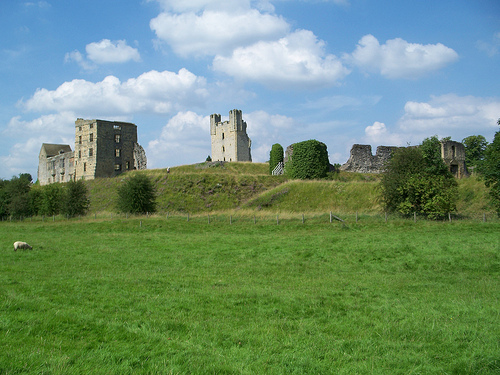

Location: Helmsley, North Yorkshire Map
Constructed: 1186- 1227
Entrance Fee: adult £4.70, children (5- 15 yrs) £2.90
Open: Apr- Sept 10am-6pm Mar & Oct 10am-5pm
Nov- Feb 10am-4pm Thu-Mon
Helmsley Castle is a medieval castle situated in Helmsley, North Yorkshire in United Kingdom. First wooden fortress of Helmsley Castle was constructed in 1120 by Walter Espec, a prominent military leader during reign of Henry I. After his death Helmsley Castle passed to his sister Adelina who married Peter de Roos. Current stone military citadel was constructed in 1186- 1227 by the orders of Robert de Roos replacing earlier wooden structures. The fort remained in the possesion of the family until 1478 when Edmund de Roos sold it to Richard, Duke of Gloucester who became known as Richard III. English king was killed in the Battle of Bossworth (defeated by House of Lancasters on 22 August 1485) and Edmund got his castle back by new king Henry VII. Talking about making a good deal.
Around 1120, Walter l'Espec built a wooden castle. He died childless
in 1154 and so the castle fell to his sister Adelina, who was married to
Peter de Roos. In 1186, Robert de Ros, son of Everard de Roos, began
converting the wooden castle into a stone one. He had two main towers,
the round corner towers and the main entrance built on the south side of
the castle. He died in 1227 and left the castle to his elder son
William, who lived there from 1227 to 1258. The only change to the
castle during this period was the construction of a chapel in the
courtyard.
William's son, Robert, inherited the castle and was
Lord of Helmsley from 1258 to 1285. He had the east tower built, as well
as a new knight's hall and a new kitchen. He also had the castle
strengthened. He also built a wall separating Helmsley Castle into a
north and south part. The southern half with the new knight's hall and
the east tower was for private use by the lord's family. The northern
half with the old knight's hall was reserved for the steward and other
servants. Robert died in 1316.
Helmsley Castle remained in the
Ros family until 1478. Edmund de Ros then sold the castle to Richard,
Duke of Gloucester, who later became King Richard III. became. Richard
didn't change anything about the castle; he resided at Middleham Castle
instead. After the death of Richard III. at the Battle of Bosworth, King
Henry VII returned Helmsley Castle to Edmund de Ros.
Edmund de
Ros died childless in 1508 and the castle fell to his cousin, Sir George
Manners of Etal. After his death in 1513 his son Thomas inherited the
castle. He was made Earl of Rutland in 1525. On his death in 1543 his
son Henry took his place, but it was his grandson Edward who rebuilt
Helmsley Castle again. He had the old Great Hall converted into a Tudor
mansion and the 13th-century chapel into a kitchen, connected to the old
Great Hall by a covered gallery. He had the new knight's hall torn down.
The southern barbican was converted into a comfortable dwelling for the
time. A letter dated April 1578 describes the slow progress of the
masonry work and states that timber was available for the mansion's
attic gallery. After Edward's death in 1587 his brother, John Manners,
inherited the castle, followed by John's son Roger and then Roger's
younger brother Francis. On the death of Francis Manners in 1632 the
castle passed to George Villiers, 1st Duke of Buckingham, who was
married to Francis' daughter Katherine. In 1639 the castle was painted
by Alexander Keirincx.
Helmsley Castle was besieged by Thomas
Fairfax in 1644 during the English Civil War. Sir Jordan Crosland held
it for the king for three months and then had to surrender. Parliament
ordered the castle demolished so that it could no longer be used. Most
of the walls, gates and part of the east tower were destroyed. But the
mansion was spared. The castle was then owned by George Villiers, 2nd
Duke of Buckingham, who married Mary, daughter of Thomas Fairfax, in
1657.
On his death in 1687 the castle was sold to Charles
Duncombe, a banker and politician who was knighted in 1699 and became
Lord Mayor of London in 1708. His sister Mary's husband, Thomas Brown,
inherited the castle after Charles Duncombe's death in 1711. Thomas
subsequently changed his family name to 'Duncombe'. He commissioned John
Vanbrugh to build a country house in Duncombe Park, towering over the
castle. He left Helmsley Castle to decay. It is still owned by the
Feversham family at Duncombe Park but is managed by English Heritage.